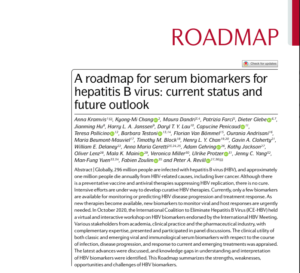
Post-Doctoral and Doctoral positions opened within HepVir team, CIRI-INSERM U1111, Lyon, France
POSTED ON: 15 Aug, 2022


This article was originally published on Doherty Institute website. Find the original article here.
The urgent need for improved Hepatitis B virus (HBV) biomarkers – indicators found in blood, bodily fluids or tissue used to measure disease progression and response to treatment – has been considered in a seminal roadmap publication ahead of World Hepatitis Day this Thursday, 28 July.
Published in Nature Reviews – Gastroenterology & Hepatology, the roadmap authored by 29 world-leading experts in HBV research, clinical practice, the pharmaceutical and biotech industries, analyses the strengths, weaknesses and opportunities of serum HBV biomarkers.
Roadmap co-lead author University of Melbourne Professor Peter Revill, a lab head at the Victorian Infectious Diseases Reference Laboratory (VIDRL), Royal Melbourne Hospital at the Peter Doherty Institute for Infection and Immunity (Doherty Institute) said new biomarkers are needed to better follow HBV infection in patients.
“As promising new drugs for treating hepatitis B become available, we urgently need new biomarkers to reliably monitor the effectiveness of these treatments in our patients,” Professor Revill said.
“This roadmap – the first of its kind in the academic literature on HBV – has identified the path forward for academia, clinicians and industry to secure better serum biomarkers.”
296 million people are infected with HBV globally and about one million people die each year from HBV-related causes, including liver cancer. While a preventative vaccine and antiviral therapies to suppress HBV are available, there is no cure.
All member states of the World Health Organization have committed to the goal of eliminating viral hepatitis as a public health threat by 2030.
In October 2020, as the global COVID-19 pandemic restricted travel worldwide and threatened to stymie the promising progress from the previous year’s International HBV meeting in Melbourne, Australia, the International Coalition to Eliminate Hepatitis B Virus (ICE-HBV) held virtual interactive workshops on HBV biomarkers.
HBV experts from academia, clinical practice and the pharmaceutical industry participated in webinars and panels, discussing the usefulness of both classic and emerging viral and immunological serum biomarkers to monitor HBV infections, disease progression and responses to current and new treatments.
“Crucially, HBV has a reservoir of covalently closed circular DNA (cccDNA, a mini-chromosome) in the nucleus – and this reservoir is not targeted by current therapies,” Professor Revill explained.
“This poses a real challenge, as the only means of analysing this reservoir is to subject our patients to liver biopsy.”
The roadmap recognises that liver biopsies will be increasingly difficult to undertake, and serum biomarkers are necessary as surrogate markers of activity in the liver.
Roadmap co-lead author, University of the Witwatersrand Professor Anna Kramvis, Director of the Hepatitis Virus Diversity Research Unit, School of Clinical Medicine at University of the Witwatersrand, said that challenges and opportunities, including increasing demand on healthcare systems, patient hesitancy, promising immune response enhancing treatments and future disruptions like the COVID-19 pandemic, underscore the urgent need for alternative HBV biomarkers.
“Emerging treatments to improve patients’ immune responses to fight HBV will require better serum biomarkers in order to reduce dependence on liver biopsies” Professor Kramvis said.
“Hepatitis B is an immune mediated disease and people living with chronic HBV experience a reduced immune response to the virus and infected cells. As the pharmaceutical industry explores treatments to enhance this suppressed immune response, we will need serum biomarkers to observe the effectiveness of these treatments more easily.”
Developing alternative methods, to analyse serum biomarkers and to monitor cccDNA in the liver, would assist pharmaceutical producers and clinicians in monitoring the effectiveness of new treatments to induce functional cure, defined as the loss of HBV surface antigen, which allows a patient’s immune system to fight and reduce HBV in the body.
The roadmap also considers the promise of emerging technologies to replace existing liver biopsy methods.
“Fine needle aspirants (FNA’s) use an even smaller needle than those used for current liver biopsies, that are much easier to administer – far less impactful and invasive on the patient,” Professor Revill said.
“Immunologists have discovered that you can get a lot of useful information about HBV from these FNA’s.”
The roadmap also notes the importance of working closely with the HBV-affected community to develop cure strategies for patients.
Engagement with the HBV-affected community worldwide is critical to ensure equitable access to new therapies for all who need them, Professors Revill and Kramvis agree.
Professors Revill and Kramvis are grateful for the input of their fellow roadmap authors, who presented papers, chaired sessions, and participated in panel discussions at the workshop.
“The roadmap demonstrates a truly collaborative global effort to summarise our knowledge on current biomarkers, emerging biomarkers, and identifying what the field of HBV research and treatment needs to move forward as we work toward our shared goal of eliminating viral hepatitis in the foreseeable future.”
Peer review: https://doi.org/10.1038/s41575-022-00649-z

The European Liver Patients Association (ELPA), IP-cure-B, ANRS | EID, and Inserm organized the event “Raising Awareness on Viral Hepatitis Elimination.” Topics include:
You can rewatch the event here:
We are delighted to share our HBV Serum Biomarkers manuscriptm, recently published online at Nature Reviews Gastroenterology and Hepatology. This publication is an important review, which culminates almost 2 years work since the ICE-HBV Serum Biomarkers workshops online in 2020.
Globally, 296 million people are infected with hepatitis B virus (HBV), and approximately one million people die annually from HBV-related causes, including liver cancer. Although thereis a preventative vaccine and antiviral therapies suppressing HBV replication, there is no cure.Intensive efforts are under way to develop curative HBV therapies. Currently, only a few biomarkersare available for monitoring or predicting HBV disease progression and treatment response. Asnew therapies become available, new biomarkers to monitor viral and host responses are urgentlyneeded. In October 2020, the International Coalition to Eliminate Hepatitis B Virus (ICE-HBV) helda virtual and interactive workshop on HBV biomarkers endorsed by the International HBV Meeting.Various stakeholders from academia, clinical practice and the pharmaceutical industry, withcomplementary expertise, presented and participated in panel discussions. The clinical utility ofboth classic and emerging viral and immunological serum biomarkers with respect to the courseof infection, disease progression, and response to current and emerging treatments was appraised.The latest advances were discussed, and knowledge gaps in understanding and interpretationof HBV biomarkers were identified. This Roadmap summarizes the strengths, weaknesses,opportunities and challenges of HBV biomarkers.
For more ICE-HBV publication, check out our Publication Page here.

has been involved for nearly ten years in research programs aimed at curing hepatitis B virus (HBV) and Delta virus (HDV) infections. Every year, the ANRS HBV Cure Task Force organizes a workshop bringing together international experts to discuss the recent advances in our understanding of chronic hepatitis B and Delta, and to present the progress in the discovery of new therapeutic targets and advances in clinical development. On the occasion of World Hepatitis Day on July 28th 2022, Fabien Zoulim, professor of medicine in Lyon, coordinator of the European project “IP-cure-B”, the RHU project “CirB-RNA”, the ANRS Task Force “HBV Cure” and current chair of ICE-HBV presents the take home messages from the 9th HBV cure workshop held in Lyon on July 5th, 2022.
Background: Despite the fact that an effective vaccine is available, hepatitis B still represents a major global public health problem today. According to the WHO, there were still 296 million chronic carriers of the virus worldwide in 2019; this disease is also the leading cause of liver cancer. HBV and its complications contributed to 820,000 deaths in 2019. Co-infection with HDV worsens the disease and increases the risk of developing cirrhosis or liver cancer. There are currently no curative treatments for these two types of hepatitis.

Virological aspects. Recent data concerning the viral reservoir (HBV cccDNA) were presented during the workshop. Recent data were presented on how this reservoir is formed and regulated during chronic infection, and how it could be targeted, in particular by using new “genetic scissors” approaches.
Immunological aspects. Recent data were discussed on the mechanisms involved in the defects in the immune responses of patients to discover novel pathways to restore them to effectively control or eliminate the virus. In particular, new approaches such as therapeutic vaccines were discussed.
The evaluation of the hepatic compartment at the virological and immune levels is critical to determine the impact of the new therapeutic approaches on the viral reservoir and on the antiviral immune responses in the site of infection. Experts have studied new approaches to analyze the liver compartment, which are less invasive than liver biopsy, such as fine needle aspirations. New PCR and immunology technologies allow now to investigate the viral reservoir and immune responses on FNA samples in proof of concept clinical trials. This should generate crucial information for the development of new therapeutic approaches.
A comprehensive review of the most recent clinical trials was presented and has shown that this field of research is very dynamic: many antiviral molecules and several immunotherapy strategies are in phase II clinical trials, most often in combination therapy, either with direct antivirals or with direct antivirals and immunotherapy. Great advances have been made on certain classes of molecules such as capsid assembly modulators and on strategies targeting viral RNAs (siRNAs or antisense oligonucleotides).
For hepatitis Delta, a virus entry inhibitor (bulevirtide) has been conditionally approved by the European Medicines Agency (EMA) in July 2020- taking into account that so far no treatment was available for this disease. The modalities of administration are being developed pending the results of phase III clinical trials. Other antiviral molecules are also being studied in various clinical trials.
The ANRS | Emerging infectious diseases sponsors and funds a Delta cohort study, ANRS HD EP01 BuleDelta, (monitoring of HDV patients on bulevirtide) which has already included 193 patients in 30 centers. It is also sponsoring the IP-Cure-B study (ANRS HB07 IP-Cure-B ), an European-funded randomized clinical trial which aims to stimulate antiviral immune responses by a TLR8 agonist (Selgantolimod) and which has already included 6 patients in France.
Learn more here:

ICE-HBV is working on an international collaborative research review project about HBV management in resource-limited settings (RLS), led by Daryl Lau and Manal El Sayed. The main objective of the project is to improve access to/quality of HBV care in RLS and reduce HBV mortality and incidence.
We are therefore inviting individuals and organizations working on HBV in resource-limited settings to complete a survey developed to elaborate improved Point-of-Care models for HBV management in RLS. Your input will inform our work on this pressing topic. The survey should take around 15-20 minutes and can be found in the links below:
If you have any questions or issues with the survey, feel free to contact ICE-HBV Program Associate Jennifer Pampolina at jpampolina_AT_excolo.com.sg
Thank you in advance for your help and important contribution to this project.
Download the Survey Invite here
If you have any questions or issues with the survey, feel free to contact ICE-HBV Program Associate Jennifer Pampolina at jpampolina@excolo.com.sg
Feel free to forward this message to colleagues and organizations that also work on HBV in RLS.
Thank you in advance for your help and important contribution to this project.


“Every year, more than 800,000 people worldwide die from hepatitis-B-related liver disease — a greater toll than from malaria. But efforts to curb transmission and discover a cure are picking up steam.”
Article Features & Comment